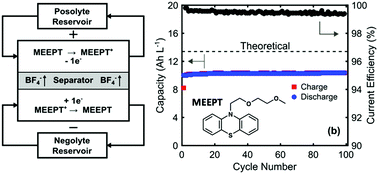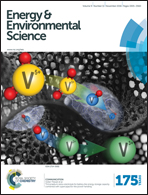High current density, long duration cycling of soluble organic active species for non-aqueous redox flow batteries†
Abstract
Non-aqueous redox flow batteries (NAqRFBs) employing redox-active organic molecules show promise to meet requirements for grid energy storage. Here, we combine the rational design of organic molecules with flow cell engineering to boost NAqRFB performance. We synthesize two highly soluble phenothiazine derivatives, N-(2-methoxyethyl)phenothiazine (MEPT) and N-[2-(2-methoxyethoxy)ethyl]phenothiazine (MEEPT), via a one-step synthesis from inexpensive precursors. Synthesis and isolation of the radical-cation salts permit UV-vis decay studies that illustrate the high stability of these open-shell species. Cyclic voltammetry and bulk electrolysis experiments reveal the promising electrochemical properties of MEPT and MEEPT under dilute conditions. A high performance non-aqueous flow cell, employing interdigitated flow fields and carbon paper electrodes, is engineered and demonstrated; polarization and impedance studies quantify the cell's low area-specific resistance (3.2–3.3 Ω cm2). We combine the most soluble derivative, MEEPT, and its tetrafluoroborate radical-cation salt in the flow cell for symmetric cycling, evincing a current density of 100 mA cm−2 with undetectable capacity fade over 100 cycles. This coincident high current density and capacity retention is unprecedented in NAqRFB literature.



 Please wait while we load your content...
Please wait while we load your content...